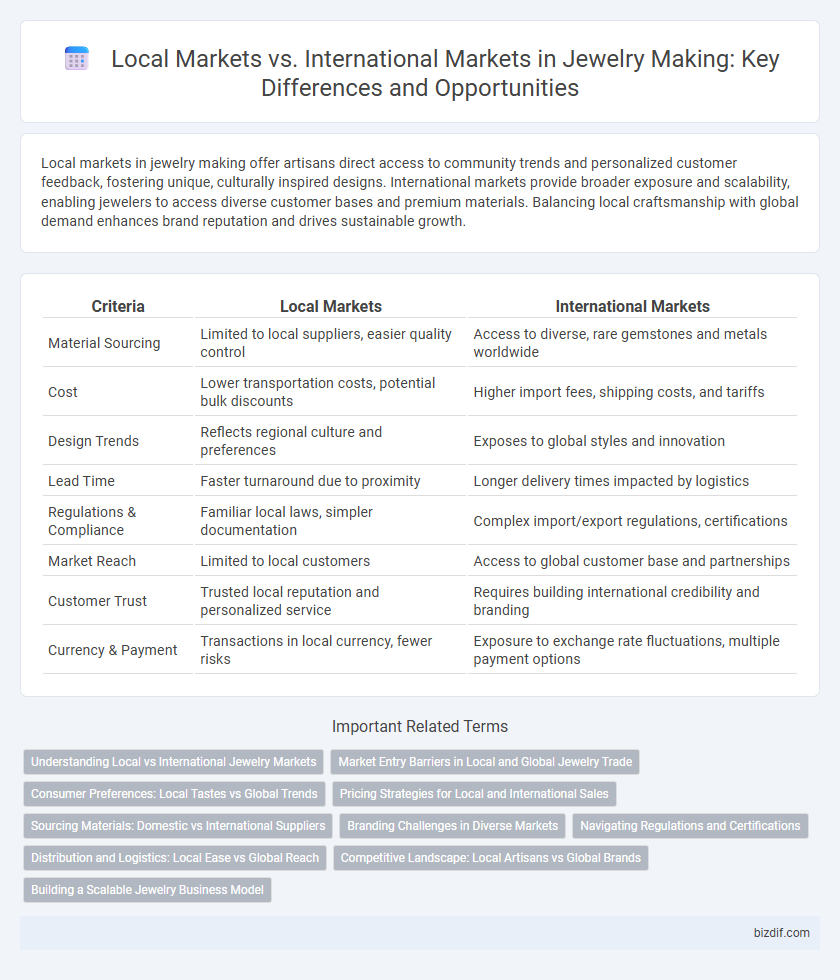Local markets in jewelry making offer artisans direct access to community trends and personalized customer feedback, fostering unique, culturally inspired designs. International markets provide broader exposure and scalability, enabling jewelers to access diverse customer bases and premium materials. Balancing local craftsmanship with global demand enhances brand reputation and drives sustainable growth.
Table of Comparison
| Criteria | Local Markets | International Markets |
|---|---|---|
| Material Sourcing | Limited to local suppliers, easier quality control | Access to diverse, rare gemstones and metals worldwide |
| Cost | Lower transportation costs, potential bulk discounts | Higher import fees, shipping costs, and tariffs |
| Design Trends | Reflects regional culture and preferences | Exposes to global styles and innovation |
| Lead Time | Faster turnaround due to proximity | Longer delivery times impacted by logistics |
| Regulations & Compliance | Familiar local laws, simpler documentation | Complex import/export regulations, certifications |
| Market Reach | Limited to local customers | Access to global customer base and partnerships |
| Customer Trust | Trusted local reputation and personalized service | Requires building international credibility and branding |
| Currency & Payment | Transactions in local currency, fewer risks | Exposure to exchange rate fluctuations, multiple payment options |
Understanding Local vs International Jewelry Markets
Local jewelry markets prioritize cultural preferences, handmade craftsmanship, and regional materials, driving unique and customizable designs. International jewelry markets emphasize global trends, mass production, and brand reputation, catering to diverse consumer bases with varied price points. Understanding these distinctions helps artisans and businesses tailor strategies for pricing, marketing, and product development across both domains.
Market Entry Barriers in Local and Global Jewelry Trade
Local jewelry markets often present lower entry barriers due to established community trust, familiar regulations, and direct consumer access, facilitating easier brand recognition and personalized marketing. In contrast, international markets impose complex challenges such as stringent import-export laws, cultural preferences, higher tariffs, and intensified competition from established global brands. Navigating global jewelry trade demands strategic compliance with diverse regulatory frameworks and adaptation to varying consumer behaviors to ensure successful market penetration and sustained growth.
Consumer Preferences: Local Tastes vs Global Trends
Local jewelry markets thrive on unique cultural designs, traditional craftsmanship, and region-specific materials that appeal to consumers seeking authenticity and heritage. International markets prioritize contemporary styles, innovative techniques, and brand prestige, attracting buyers driven by global fashion trends and luxury status. Understanding these differing consumer preferences is essential for jewelers to tailor collections that resonate either with localized tastes or broader global demands.
Pricing Strategies for Local and International Sales
Local markets in jewelry making often demand competitive pricing tailored to regional purchasing power and consumer preferences, enabling artisans to build strong community ties and repeat customers. International markets require strategic pricing that accounts for currency fluctuations, import duties, and higher shipping costs, while maintaining perceived value and brand prestige. Balancing affordability for local buyers with premium pricing for global clients maximizes profitability and market reach.
Sourcing Materials: Domestic vs International Suppliers
Sourcing materials from local markets in jewelry making ensures faster delivery times, better quality control, and supports regional artisans, resulting in unique and ethically sourced components. International suppliers offer access to a wider variety of rare gemstones and metals but may involve longer lead times and increased costs due to import regulations and tariffs. Balancing domestic sourcing with selective international procurement optimizes material availability while maintaining cost efficiency and sustainability.
Branding Challenges in Diverse Markets
Local markets in jewelry making offer brand recognition based on community trust and cultural resonance, whereas international markets require navigating diverse consumer preferences and regulatory standards. Branding challenges include adapting marketing strategies to different cultural aesthetics, managing supply chain complexities, and overcoming language barriers to establish credibility. Consistent brand messaging aligned with local values is crucial to building a loyal customer base across varied geographic regions.
Navigating Regulations and Certifications
Navigating regulations and certifications in jewelry making requires thorough understanding of local market standards, which often emphasize cultural and regional authenticity. International markets demand compliance with global certifications such as Responsible Jewellery Council (RJC) and Kimberley Process, ensuring ethical sourcing and quality assurance. Mastery of these regulatory frameworks enables jewelers to expand their reach while maintaining trust and legality across diverse markets.
Distribution and Logistics: Local Ease vs Global Reach
Local markets offer streamlined distribution with shorter supply chains, reduced shipping costs, and quicker delivery times, making them ideal for small-scale jewelry makers focusing on nearby customers. International markets demand complex logistics management, including customs clearance, international shipping, and compliance with varied regulations, but provide access to a broader customer base and higher sales potential. Efficient inventory management systems and partnerships with global logistics providers are essential for jewelry brands aiming to scale globally while maintaining timely delivery and product integrity.
Competitive Landscape: Local Artisans vs Global Brands
Local artisans in jewelry making often emphasize handcrafted designs and cultural heritage, appealing to niche markets with personalized products and unique craftsmanship. Global brands leverage extensive resources, advanced technology, and extensive distribution networks to dominate international markets, offering consistent quality and wide product ranges. The competitive landscape balances authentic, bespoke creations from local markets against the scalability and branding power of global companies.
Building a Scalable Jewelry Business Model
Local markets offer jewelers direct consumer feedback and lower shipping costs, enabling personalized designs and quicker inventory turnover. International markets provide access to a broader customer base and higher revenue potential, requiring scalable production processes and compliance with diverse regulations. Balancing both ensures a jewelry business model that can efficiently expand while maintaining quality and brand identity.
Local Markets vs International Markets Infographic

 bizdif.com
bizdif.com